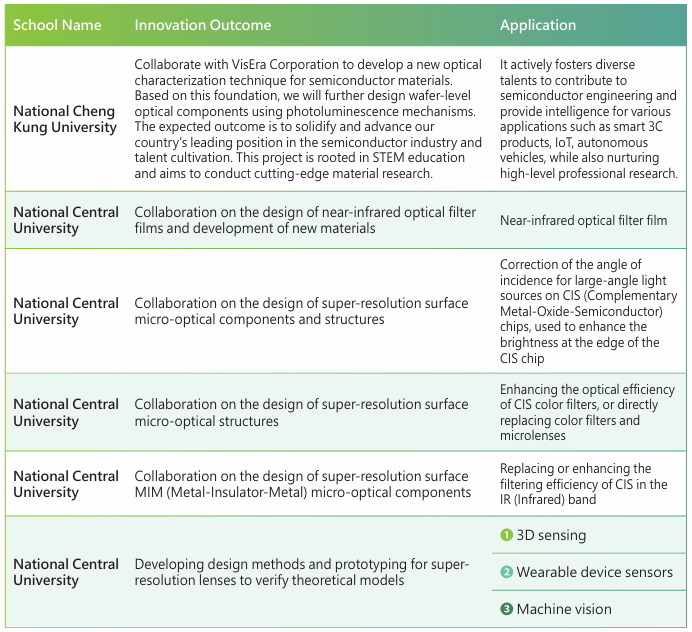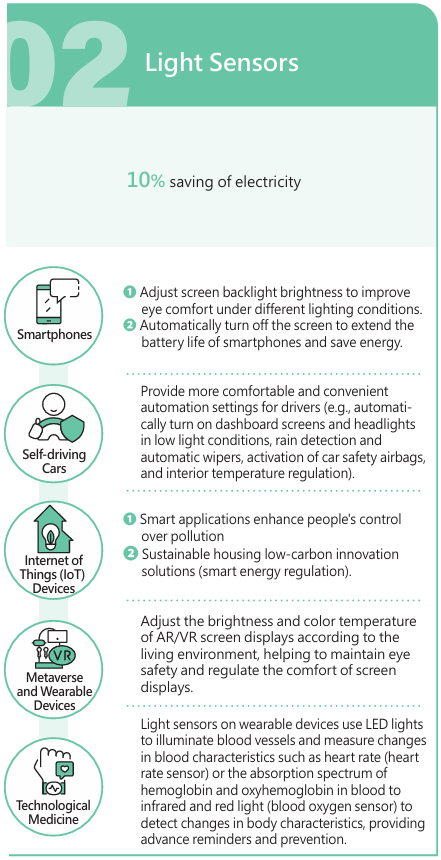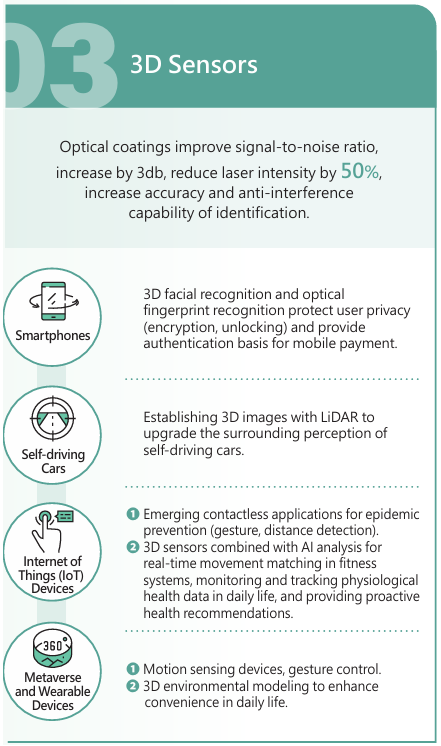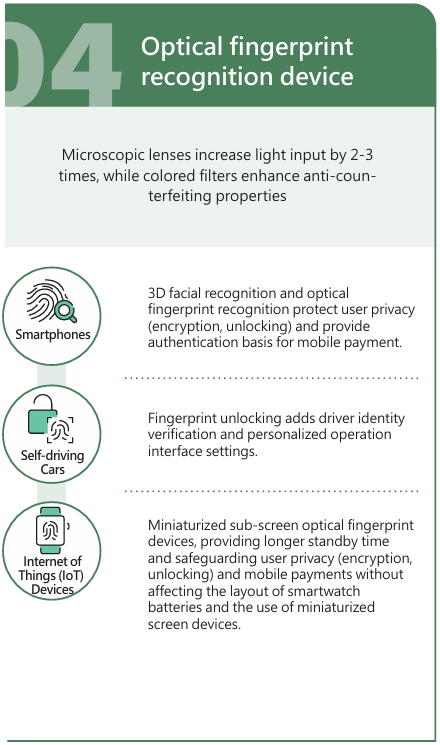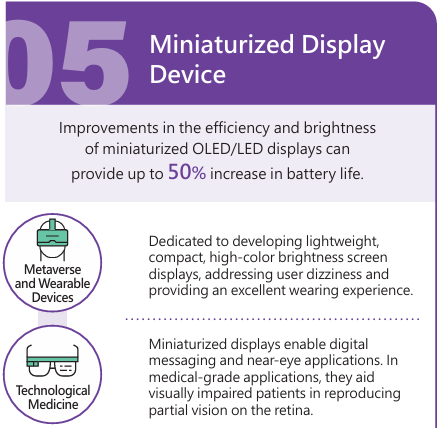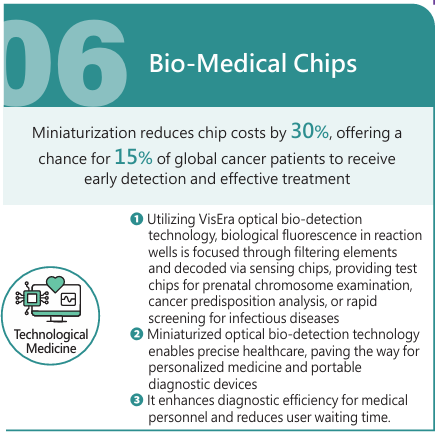3.1.1 R&D Management
R&D Management Strategy
In order to comprehensively enhance the strategic development and energy of innovation management, VisEra Corporation has established a Value Innovation Team under the ESG Sustainable Development Promotion Committee. In addition to continuously investing in advanced processes and innovative equipment to maintain technological leadership while also considering green energy and human factors improvement, we will strengthen cross-border cooperation between industry and academia and actively cultivate an innovative culture to create a work environment conducive to innovation. This will effectively enhance the competitiveness of the enterprise.
▼The contributions of products designed by VisEa Company to human society
Research and Development Management Framework
VisEra Company boasts a professional management and R&D team with extensive experience in product strategy and positioning. We continuously monitor industry information and trends in raw material prices, maintaining close communication with customers to stay abreast of industry dynamics. This enables us to continuously develope new technologies and products, thereby strengthening our company's competitiveness.
R&D division organization:

Note: For details on R&D unit and its activities, please refer to2022 Sustainability Report/Chapter 3.1.1 R&D Management.
Investment in Innovative Research and Development
VisEra is committed to technological innovation and research and development of proprietary technologies. In 2023, it invested approximately 730 million New Taiwan Dollars in R&D, accounting for 10.0% of its revenue. Over the past three years, it has steadily increased its R&D expenditure annually to develop key technologies and consolidate its leading position.
Annual Product Innovation Achievements and Applications
Note: For detailed information on product innovation applications, please refer to VisEra's official website, Dedicated Optical Foundry/Main Product/Application.
Spotlight
Development of GPU High-Speed Computing Technology for Finite Time Domain Difference Method
VisEra has traditionally focused on the manufacture of optical components. However, in recent years, with the rapid advancement of nanophotonic technology, its pace has accelerated significantly. In the ever-changing future market, competition with global leading companies no longer relies solely on manufacturing capabilities; research and development innovation are equally crucial. There remain many unknowns in the principles of wave optics, and the scope of R&D innovation includes not only optical design but also challenges in measurement technology. Additionally, in the optimization of meta-surfaces, apart from overcoming the physical limits of optics, the demand for computational resources has become more complex, posing a bottleneck for both international academic institutions and industries. Therefore, optimization directions not only require the development of accurate and fast computational models based on theoretical foundations but also efficient allocation of limited computer resources.
The theoretical development of nanophotonic technology is poised to disrupt the reliance on geometric optical products in the past. Its application scope includes hyperlens (for machine vision), metasurface dot matrix projectors (for detection and facial recognition), environmental sensors, AR/VR wearable devices, and color routers. If nanophotonic theory, GPU-FDTD high-speed computing technology, and measurement technology can be developed with mature mathematical models and experimental frameworks, coupled with manufacturing capabilities, VisEra's relevant optical products will undergo a revolutionary comprehensive upgrade. VisEra will be capable of providing customers with comprehensive OEM services from design to manufacturing.
Additionally, in the optimization of meta-surfaces, apart from overcoming the physical limits of optics, the demand for computational resources has become more complex, posing a bottleneck for both international academic institutions and industries. Therefore, optimization directions not only require the development of accurate and fast computational models based on theoretical foundations but also efficient allocation of limited computer resources.
The theoretical development of nanophotonic technology is poised to disrupt the reliance on geometric optical products in the past. Its application scope includes hyperlens (for machine vision), metasurface dot matrix projectors (for detection and facial recognition), environmental sensors, AR/VR wearable devices, and color routers. If nanophotonic theory, GPU-FDTD high-speed computing technology, and measurement technology can be developed with mature mathematical models and experimental frameworks, coupled with manufacturing capabilities, VisEra's relevant optical products will undergo a revolutionary comprehensive upgrade. VisEra will be capable of providing customers with comprehensive OEM services from design to manufacturing.
Development and Prototyping of Super-Resolution Lens Design Technology
Lenses are widely used optical components, with optical products including smartphones, LiDAR, AR/VR glasses, etc. The miniaturization of optoelectronic components has become a demand in modern optical products.
Traditional optical devices are generally bulky due to limitations in materials found in the natural world. However, in recent years, with the development of nanophotonics, sub-wavelength nanostructures can form a small and flat super-resolution interface using collective resonance to control the propagation behavior of electromagnetic waves. This brings significant benefits to the miniaturization of optoelectronic components. If future developments can achieve functions such as chromatic aberration and distortion correction, super-resolution lenses have the potential to completely replace bulky traditional optical devices, thereby greatly changing the ecology of optical products.
VisEra has rapidly developed in recent years in the field of super-resolution interface processing technology, becoming a key process supplier for internationally renowned optical manufacturers. Given the current trend, interest in super-resolution interfaces among potential large-scale customers continues to grow. If VisEra can provide both design and manufacturing services, it will facilitate smoother product development processes for clients, increasing their willingness to cooperate with VisEra.
If design technology can be successfully developed, it is expected to generate revenue for VisEra in the near future and further increase profit margins due to the uniqueness of the design technology. However, designing a super-resolution interface challenges the physical limits of optics, making its technological development quite difficult and challenging.
Furthermore, optical manufacturers with top-notch design and production capabilities are rare both domestically and internationally, especially in nurturing design capabilities, which is particularly challenging. Although there is a prototype of internal design technology development, there is a lack of actual prototypes to verify design thinking.
The purpose of this project is to accelerate the development of super-resolution lens
design capabilities and produce prototypes of super-resolution lenses that eliminate
chromatic aberration and distortion for verification.
Applications and Challenges of Hypersurface Color Routers on Image Sensors
 In recent years, the outstanding performance of hypersurface technology in the field of optics has attracted attention for its application on CMOS image sensors. Traditionally, in image sensors based on microlenses and optical filters, visible light waves uniformly enter RGB pixels. However, due to the bandwidth limitation of optical filters on pixels, the maximum theoretical sensitivity of each RGB pixel is only 33%, which means that over 60% of sensitivity is wasted. By replacing traditional microlenses with color routers made using hypersurface technology, visible light RGB waves can be "routed" to the corresponding RGB pixels, effectively increasing the sensitivity by approximately 2-3 times without increasing the volume of the image sensor.
In recent years, the outstanding performance of hypersurface technology in the field of optics has attracted attention for its application on CMOS image sensors. Traditionally, in image sensors based on microlenses and optical filters, visible light waves uniformly enter RGB pixels. However, due to the bandwidth limitation of optical filters on pixels, the maximum theoretical sensitivity of each RGB pixel is only 33%, which means that over 60% of sensitivity is wasted. By replacing traditional microlenses with color routers made using hypersurface technology, visible light RGB waves can be "routed" to the corresponding RGB pixels, effectively increasing the sensitivity by approximately 2-3 times without increasing the volume of the image sensor.
However, there are still significant challenges and difficulties in designing, manufacturing, and applying hypersurface color routers on image sensors. These include the significant optical simulation resources and time costs during design, control of linewidths and variations during production, and the impact of incident angles of light sources on sensor performance during application. These are all issues that need to be addressed and resolved in this project.
The color router developed in this project has achieved preliminary results and has entered the stage of practical production verification. It is believed that besides enhancing the performance of image sensors, this project can also cultivate VisEra's capabilities in optical design and process optimization, thereby continuously improving VisEra's competitiveness against other international image sensor manufacturers.
3.1.2 Management of Intellectual Property Rights and Trade Secret
VisEra actively promotes intellectual property right (IPR) management plans, has established regulations governing the application, maintenance, and management of IPR that relates to patents and trade secrets, and prevents the leakage of R&D achievements and critical technologies through a stringent confidential information protection system, so as to comprehensively protect the Company's intellectual properties.
The Company implements strict confidentiality protection in accordance with the Proprietary Information Protection (PIP) Policy for the R&D results in all stages. We established detailed regulations on the use, disclosure, transmission, publication, and copying of related information. We also restrict the entry and exit of computer equipment, video camera or recording devices and mobile devices to prevent unauthorized disclosure or infringement of intellectual property. If the development of a technology meets the requirements for patent application, it will be submitted to the Invention Review Committee for a technical review. If it is approved, a patent application will be filed immediately to obtain a patent to protect the Company's technology.
VisEra established the Patent Management Regulations for the protection of patents. We set up an incentive system to encourage R&D personnel to actively apply for patents for their R&D results. We consider R&D results that are not suitable for patent applications as trade secrets.We maintain strict confidentiality and protection measures in accordance with the aforementioned PIP Policy, and we established a trade secret management system in January 2022 which also provides an incentive systemthat encourage R&D personnel to integrate and present technical information for production processes, technologies, formulas, procedures, or applications for production, sales, or operations that can be used for mass production or production improvement. After they are reviewed and approved by the Invention Review Committee, we award the R&D personnel with incentives based on the level of technology. We also implement a unified storage mechanism and assign dedicated personnel to manage the storage, access, use, and modification of such information to prevent unauthorized disclosure or infringement of such information. In 2023, over one houndred personnel has recived incentives related to technology development. Since 2023 is year of VisEra’s 20th annicersary of organization, we specially award special prizes to inventors of technology with excellence performances in oder to encourage their pride and company solidarity. Besides, in 2024 VisEra will award a “Best Technology Invention of the Year” prize to the most outstanding R&D personnel to set a good example and encourage others to work hard at pursuit of excellence.
VisEra has set patent strategies in countries including the United States, Taiwan, Mainland China, and Japan. Since the organization of the Company, we have obtained more than 700 patents and the number continues to increase.
At the end of each year, the management team sets appropriate KPIs for intellectual property for the following year based on the R&D status in the R&D units of each organization, future business strategies, and patent strategies for each country. The indicators are used to encourage R&D within the Company, and the performance achievement rate has exceeded 100% in the past three years. At least once a year, the head of R&D or the head of legal affairs also reports on the current R&D progress and future R&D plans at the board meeting for the Directors to learn about the Company's plans for intellectual property rights. The report on the Company's intellectual property management plan will be provided at the board meeting in the second quarter of 2024. Since 2018, the number of VisEra's patent proposals and applications has exceeded 40 each year. To increase the efficiency of the employees' invention proposals, we completed the establishment of the proposal system in September 2021 and improved the system functions in 2022. We systematically streamlined the process and management of patent application, defense, and certification, and upgraded the system to the intellectual property case management system with the aim of achieving effective management of the Company's intellectual property rights. To help the management team and R&D personnel learn more about the intellectual property systems, future plans, and data acquisition, the Company organized digital training courses for intellectual property rights in 2023 to increase the quality and quantity of patents.
3.1.3 Foster an Open and Innovative Corporate Culture.
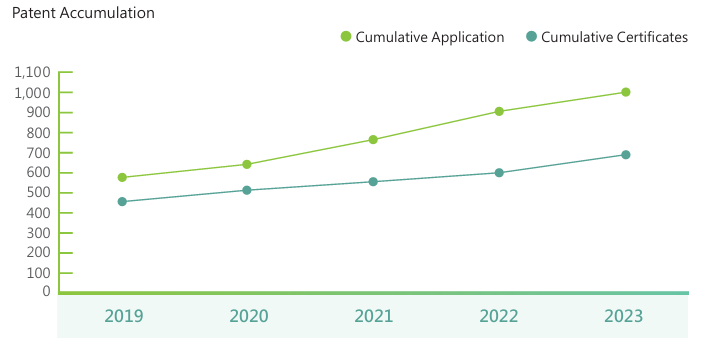
3.1.3 Foster an Open and Innovative Corporate Culture
VisEra Corporation is committed to technological innovation, aiming to strengthen its industry leadership position and safeguard hard-earned advancements in technology. To protect R&D achievements and enhance competitiveness, we employ incentive mechanisms to encourage R&D innovation. By integrating these mechanisms with the company's operational goals in patent applications, we foster a positive cycle of R&D innovation and corporate culture, laying a solid foundation for sustainable business operations.
Furthermore, while pursuing technological leadership, we also fulfill our social corporate responsibility. Through partnerships with esteemed academic institutions such as National Cheng Kung University, National Yang Ming Chiao Tung University, National Central University, and National Tsing Hua University, we engage in long-term and diversified industry-academic collaborations. In addition to leveraging the research and development capabilities of these institutions, we also contribute to the cultivation of excellent industry talents.
List of industry-academic collaboration projects in recent years

